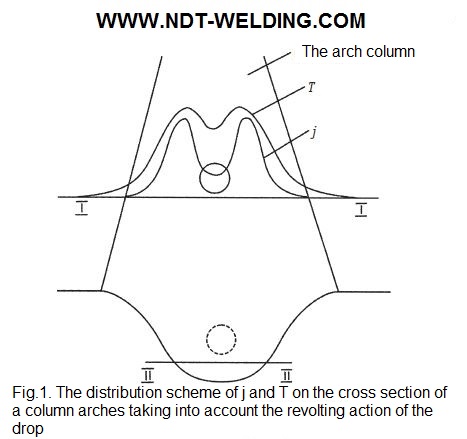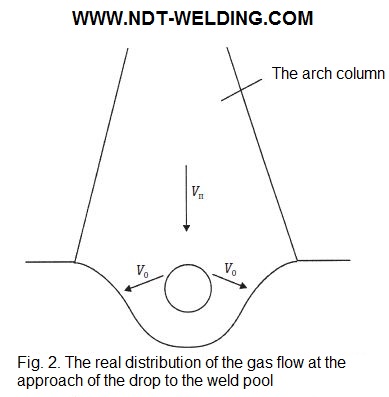The similar phenomenon shall be watched also in case of drop metal transfer, but in a little smaller level. At the same time, it is necessary to consider that the greatest vapors concentration of the metal evaporating generally from the active spot on an electrode in connection with rounding of a drop the gas flow going from an electrode, most likely, will be not on an arc pole axis under a drop, and in its peripheral parts of a drop on each side, at the same time, the vapors concentration of the electrode over a drop shall be noticeable more, than under a drop. What also promotes lowering of conductance of plasma under a drop in connection with the smaller potential of vapors ionization of metal in comparison with the potential of atoms ionization of the protective gas. It shall lead to bigger ionization degree of plasma atoms of the arc on the periphery sideways from a drop (section I-I below, see Fig. 1),

It should also be noted that the high-speed gas flow lines will, just like the current lines, deviate at the frontal surface of the drop. At the same time, the gas flow velocity under the drop will be substantially less than over the drop. This phenomenon can have a significant effect on the formation of the surface of the weld pool, as its surface is affected not only by periodic force from droplets entering the weld pool, but also by the pulsating pressure of the gas flow caused by the perturbing action of the drops.
The greatest effect of the change in the gas flow velocity, the gas temperature, and the current density in the arc column along its cross section when there is one or several drops in the column of the arc should be observed during the jet transfer of the metal when the gas flow velocity in the column of the arc is greatest (2 … 3) ・103 m/s.
It should be especially noted that when the drop approaches the surface of the weld pool, it will shield the gas flow coming from the electrode, and its velocity head will be directed mainly to the side of the crater (see Fig. 2).

It follows from this that the distribution of the gas temperature at the pool surface in this case will change and the greatest increase in its temperature due to the braking of the gas flow at the walls of the crater will be observed not at the center of the weld pool but on its periphery and, possibly, on the crater walls that are Solid unmelted metal products.
From this also follows, as gas ionization degree, so, and in this case crater walls will have its conductivity more. As the welding current passes on the smallest resistance, and distribution of current on surfaces of a crater and a welding trough in this case will change, and the welding current will pass generally through peripheral parts of a welding trough and through crater walls.
Follows from told that in a welding trough and a crater the current density and distribution of temperature on their surfaces permanently pulsate with a frequency, equal to the frequency of transfer of drops. The greatest effect of these pulsations shall be watched in case of maximum speed of a gas flow in an arc pole, i.e. in case of jet transfer of metal.






